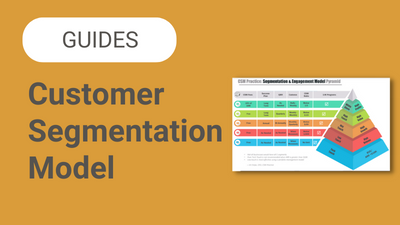Our approach to scaling a customer success team might be vastly different for strategic accounts vs. your small and mid-size business (SMB) segment. To scale, most organizations would start by segmenting their customer base and then associate a different client engagement model to each segment. The strategic and enterprise account segment would typically be assigned a “high touch” engagement model, whereas the SMB client segment would typically be assigned a lower touch engagement model.
Customer Segmentation
A solid first step in ensuring your customers are receiving a proper experience while scaling your customer success team is to take the time to properly segmenting your customer base. Most companies would take a basic approach to segmentation. A basic segmentation approach would typically include broadly classifying your accounts into three main categories: Enterprise, Mid-Market, and SMB.
If you are attempting to segment your customer base for the very first time, I recommend you start with this simple segmentation approach and then experiment with more sophisticated segmentation techniques (for example, profitability levels or adoption maturity levels).
Veriforce Archives – CSM Practice
Scaling High Touch
Some customer success teams perceive high touch as something that’s nearly impossible to scale. However, there are two main ways to scale even ‘white-glove’ operations. To scale a ‘high-touch’ team (meaning scaling the customer success team who’s responsible for your strategic and enterprise customers), you’ll need to apply technology and consistent processes to help scale their operations.
Common challenges that enterprise Customer Success managers face might include things like inefficient manual processes, being too reactive to customer demands, poor visibility of client data, and lack of productivity tools and consistent templates. Use technology to increase productivity by providing a single system where all customer activities and data reside in one place.
Additional opportunities for scalability include templates for QBR, Success Plans, and Maturity scoring models to maximize value by facilitating strategic discussions in a consistent and effective manner.
Playbooks and Templates
If you haven’t fully documented and defined your Customer Success playbooks yet, your team’s ability to scale and be productive is not at its peak. Without proper playbook templates and documentation, training new Customer Success Managers or ensuring they all provide consistent customer experience, is practically adding hours to your day or not done at all.
One of the best ways to improve the productivity of your customer success team is to create enough CSM collateral which will ensure your team members can adopt your new playbooks quickly.
Another key point to ensuring your new playbooks and templates are adopted is to involve your CSM in their creation. You may wish to ask your customer success team to develop a set of playbook templates as part of their quarterly MBO. Another way to accomplish the adoption of new playbooks is to facilitate opportunities to shadow the QBR session run by a peer.
Customer Campaigns
The fact is, you can’t afford to have your customer success managers writing invitations to your next user conference or inviting them to participate in your new webinar! These types of emails could be easily turned into a sequence email sent via your Customer Success application, in a much more effective manner. Not only your team members won’t have to send the same email content over and over again, but an automated email campaign could also include smart triggers, such as sending a reminder when the first email was not opened or clicked on.
Scaling ‘Low Touch’
One thing that may customer success executives seem to struggle to figure out is how to scale their Customer Success operations for SMB (Small and Medium business) while increasing adoption with maintaining a high level of customer satisfaction rates (NPS and CSAT). While your customer success team might already ‘cracked the code’ on how to work efficiently with strategic clients, your goal here is to deliver the same outcomes with 1:M programs, an early warning system (aka an automated customer health score), defining a Pool CSM Model and a better support line (24/7, help online center, LMS, online community, etc).
If you have thousands of customers with a relatively small ARR (Annual Recurring Revenue, you may want to consider investing in a customer success operations team. A customer operations team’s main goal will be to run your 1:M programs. They should also analyze your customer base and predetermine opportunities for new playbooks and programs to mitigate risks uncovered through the usage of statistical analysis and predictive analytics.
Summary
To scale up the operations of your customer success team, it is essential that you set up specific engagement models that would facilitate the right customer success experience for the right client segment. To be successful, it is important to take the time to truly understand your customers’ needs and craft the ideal engagement model based on a careful analysis of your customer’s feedback.
As you define your customer success framework, make sure you address the following points:
- Segment your customer base, it will help you with the prioritization process.
- Never ignore the SMB segment. While high-touch clients are beneficial for the company’s growth, whatever programs you develop for your SMB segment will be serving your high-touch customers as well and thereby provide additional support and resources to your entire customer base.
- Take the time to define your playbooks. Defining playbooks, workflows, and templates will help you reduce the time it takes you to onboard a new CSM and will also increase overall client satisfaction rates.







